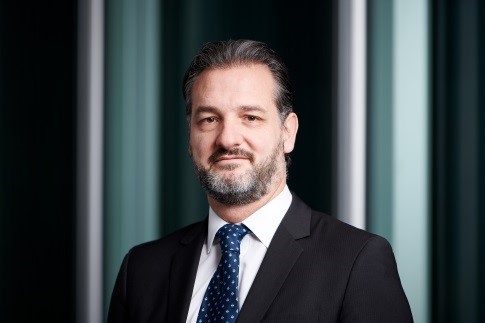In late October, Citi issued its first social bond, priced close to par, with a four-year tenor and 1.281% fixed-rate coupon. Proceeds will be used to finance healthcare, affordable housing, education and other goods and services that meet the bank’s social principles. Jorge Rubio Nava, global head of social finance at Citi, talks about the new bond as well as the evolution of Citi’s culture and policy with respect to ESG.

GF: How does this new social bond fit with Citi’s overall efforts in ESG and sustainability?
Jorge Rubio Nava: As you know, recently we made a commitment—a $1 trillion commitment—to sustainable finance, of which $500 billion is aligned with environmental financing and $500 billion is aligned with social financing. This inaugural Citi Social Finance bond is on the social side, and although it’s something new, it is basically a continuation and expansion of the work we do to drive financial inclusion and advance social development around the world. This is something that has been at the top of our agenda for over 15 years.
GF: This bond targets not just financial inclusion, but also housing, healthcare, education, etc. What’s the overall approach?
Rubio Nava: Our team—Citi Social Finance—is a global industry specialist group that unifies our social finance efforts across businesses and geographies where we do business. When we started, our work was mostly about financial inclusion—to help local financial institutions that were reaching the underserved and the “last mile” segment, by providing them financial solutions and leveraging our local capabilities so we could deliver them the funding and other services they needed to expand their outreach.
What has happened more recently is that for those customer segments—the segments that microfinance institutions and local banks reach—we have been finding some very interesting models that reach that same segment but with products that provide access to different basic services. These could be in education, healthcare or affordable housing but also things like smallholder-farm financing in emerging markets. So, it connects well and, coupled with technology developments, has made this a very vibrant segment for us.
GF: How is technology impacting social finance and how is it changing your competitive landscape, with fintechs and telcos poking into banking servces?
Rubio Nava: Well, early last year we launched a research report with our colleagues here at Citi Global Perspectives & Solutions, called Banking The Next Billion. One of the conclusions of that report was that the challenge is huge—there are around 1.7 billion people still unbanked in emerging markets. Over the last, let’s say 10 years, 800 million people have joined the system, so that’s massive progress.
Still, another 700 million people are expected to join the financial system in the next four to five years. That’s possible mostly because of all these entities you mentioned—the fintechs and the telcos with the banks—the collaboration among them, and all this technology that for the first time can viably reach this population. Through technology, these customers are having for the first time a financial identity, a bank account, a payments platform, and that has enabled other models of financial services.
I would say this is still a huge challenge—financial inclusion around the world—that cannot be met by any one entity, industry or government. It has to be a collaboration between the different parties. “Inclusive fintechs” (as we call them) and telcos are our clients, our partners, and together we are reaching the underserved.
GF: What’s the structure and history of the social finance team? How do you work with the rest of the company?
Rubio Nava: The Citi Social Finance team has been together for 15 years with different names. We started as Citi Microfinance, then evolved into Citi Inclusive Finance. Now we’re called Citi Social Finance and we are a specialist team that works across Citi’s businesses and across geographies.
We recognize that when it comes to reaching the underserved and financially excluded populations around the world, there are certain risks and certain specialty areas that we need to understand very well. This is why we have this team: to partner with our existing businesses to build client partnerships and client solutions that reach the last mile. We announced recently that this team would be expanded in size and scope to collaborate with other existing businesses and areas of the bank. There is a lot of expertise within different pockets of the bank, so we are a complement to all of that.
GF: How many are on the social finance team specifically?
Rubio Nava: Currently we are a small team in London: 10 professionals, bankers that do social finance around the world and partner with existing business lines. We have significant operations in countries like Mexico and India, which are two of the largest and most important emerging markets for Citi, where there is a lot of social finance activity. We are active with social finance transactions in over 40 markets, and the only way we can do this is because we have this very close collaboration with colleagues internally. I think that’s what’s unique about Citi: our local presence, the understanding of the local dynamics, the local languages, local currencies. That’s a key part of our model.
GF: I assume you used to fly quite a bit, but not much lately.
Rubio Nava: We do Zoom a lot. When we started 15 years ago, obviously there was much more traveling. There was due diligence we had to do in order to understand the risks, to understand the models of these entities, to ensure that they were aligned with our responsible lending principles, for example, which we care deeply about. So there was a lot of internal and external education for us. Being humble, open to learning a lot from local institutions that had been doing social finance for a long time, their track records and specific methodologies. Because we have been doing this for many years, we have developed this local expertise. So we have a team of industry specialists here in London, but we have our expanded teams of specialists on the ground in different countries.
What is unique about Citi is the globality of our network, the number of regions and countries where we are present, and also the depth of our relationships. We have, for example, a very strong public sector group, and we partner with them often because the solutions we build might be for a multilateral agency or government-owned entity, so we leverage those relationships to create those solutions. We have another specialist team, the Export and Agency team, and that’s their focus. By partnering with them we can work at scale, because we can create more capacity when we bring in partners like development finance institutions.
We also have coverage teams that have strong access to investors who have an appetite for this type of asset or solutions. We are seeing especially after Covid-19 how the need for ESG has become more obvious to everyone—the necessity of doing something that has positive social impact and to tackle these inequalities.
GF: What have you learned about differences in geographies, cultures, etc. from your work “on the ground” around the world?
Rubio Nava: Great question. The reason why there’s still a lot of financial exclusion in the world is because sometimes banks haven’t been able to develop the right methodologies and understanding of these segments with no credit histories or track records. What we’ve learned is that these segments are bankable, are creditworthy, if we use the right methodologies and the right approaches. And those differ from one region to another. There are regions where group lending in microfinance is very common and works really well. There are other regions where that doesn’t apply as much and individual lending is perhaps more frequent.
But what I think is constant across emerging markets is that there is a high proportion of female borrowers in the microfinance space—of our clients, the end-borrowers are typically about 80% women. We’ve helped to benefit more than 3.5 million low-income female entrepreneurs in these markets because of this work.
GF: Is social finance charity?
Rubio Nava: When we started this, we knew that if we wanted this activity to be scalable and replicable around the world, we needed to apply the best of our products, the best of our banking capabilities, for this sector or industry to grow at its potential.
We were very clear when we started 15 years ago that these transactions and client relationships had to meet institutional return requirements, meet our policies, and be embedded in our businesses. We complement the great philanthropic work the Citi Foundation does, but this is a business proposition for the bank. This is about working with our products and working with our business colleagues around the world to make this an asset class that can be explored by us and other banks.
GF: What about the dark side of microfinance? Exploitation of the vulnerable?
Rubio Nava: Social finance is embedded in our risk policies and procedures. This team brings a discipline to assessment of opportunities around the world. One of the things we look at very thoroughly is whether projects match the responsible finance principles that we have in place. We do very thorough due diligence on our partners to be sure that the pricing makes sense in local contexts, that collection practices are how they are supposed to be, the products are transparent and people have the ability to make claims when there is a problem. We look at all of that in every transaction that we do.
GF: At Citi, who are the key champions of these efforts outside the specific line leaders?
Rubio Nava: [CEO] Jane Fraser has set the tone for our commitments, and she brings a fresh perspective. She was covering Latin America before taking the helm as CEO, so she understands emerging markets very well. She sees the challenges, the gap, the need. So our leadership is totally championing this work. This is about leveraging what we have—all our existing offerings—and focusing them on social impact. Embed social impact in everything we do: That’s the mandate we’ve been given by leadership.
GF: This is the “inaugural” social bond, so presumably there are more to come.
Rubio Nava: This is an asset class that we see has been expanding for years and we expect that evolution to continue. We are seeing our clients are getting deeper into these segments. We are seeing technology having an exponential effect on financial inclusion and social impact finance. We think we’ll see this continue to grow going forward, and we’ll come back to the market with more offerings similar to this one.



